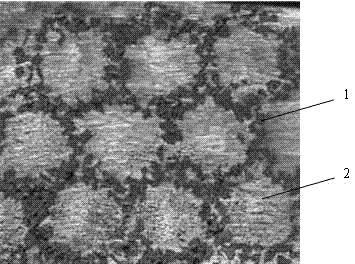Method for reducing pouring temperature of iron-based surface composite material
A surface composite material and pouring temperature technology, applied in the field of iron-based composite materials, can solve the problems of difficulty in sand mold preheating, performance degradation of high-chromium cast iron, difficulty in meeting the requirements of the workpiece for wear-resistant layer thickness, etc., and achieve easy operation , low cost effect
- Summary
- Abstract
- Description
- Claims
- Application Information
AI Technical Summary
Problems solved by technology
Method used
Image
Examples
Embodiment 1
[0016] This embodiment specifically implements a method for reducing the pouring temperature of the particle-reinforced iron-based surface composite material. The thickness of the surface composite layer of the iron-based composite material to be prepared is 30 mm. The specific process is: 2 O 3 Powder, Cr 2 O 3 The powder and Al powder are mixed in a mass ratio of 15:5:10 by ball milling until they are uniform, and then pressed into a cylinder with a diameter of 5mm and a length of 33mm under a pressure of 50MPa, and are wrapped in aluminum foil and heated at 150°C 40min, then fix the columnar reactant on the inner wall of the flask by bonding method, and put it into a ceramic particle preformed block with hexagonal prism holes made of fused zirconium corundum particles by conventional adhesive bonding method , The inner circle diameter of the hexagonal prism hole is 7mm, and the hexagonal prism hole corresponds to the position of the cylindrical reactant, and each hole correspo...
Embodiment 2
[0018] This embodiment specifically implements a method for reducing the pouring temperature of the particle-reinforced iron-based surface composite material. The thickness of the surface composite layer of the iron-based composite material to be prepared is 40 mm. The specific process is: 2 O 3 Powder, Cr 2 O 3 The powder and Al powder are mixed in a mass ratio of 21:9:10 by ball milling until uniform, and then pressed into a cylinder with a diameter of 8 mm and a length of 45 mm under a pressure of 100 MPa, which is wrapped in aluminum foil and heated at 200 ℃ 40min, then fix the columnar reactant on the inner wall of the flask by inserting method, and put it into a ceramic particle preformed block with hexagonal prism holes made of fused zirconium corundum particles by conventional adhesive bonding method. The inner circle diameter of the hexagonal prism hole is 11mm, and the hexagonal prism hole corresponds to the position of the cylindrical reactant, and each hole correspond...
Embodiment 3
[0020] This embodiment specifically implements a method for reducing the casting temperature of the particle-reinforced iron-based surface composite material. The thickness of the surface composite layer of the iron-based composite material to be prepared is 35mm, and the specific process is: 2 O 3 Powder, Cr 2 O 3 The powder and Al powder are mixed in a mass ratio of 18:7:10 by ball milling until they are uniform, and then pressed into a cylinder with a diameter of 7mm and a length of 39mm under a pressure of 80MPa, which is wrapped in aluminum foil and heated at 180°C 35min, then fix the columnar reactant on the inner wall of the flask by inserting method, and put it in the ZrO 2 Toughened Al 2 O 3 The preformed block of ceramic particles with hexagonal prism holes is made of particles. The inner diameter of the hexagonal prism hole is 9mm. The hexagonal prism hole corresponds to the position of the cylindrical reactant, and each hole corresponds to a cylindrical reactant unit. ...
PUM
| Property | Measurement | Unit |
|---|---|---|
| thickness | aaaaa | aaaaa |
| thickness | aaaaa | aaaaa |
| diameter | aaaaa | aaaaa |
Abstract
Description
Claims
Application Information
 Login to View More
Login to View More - R&D
- Intellectual Property
- Life Sciences
- Materials
- Tech Scout
- Unparalleled Data Quality
- Higher Quality Content
- 60% Fewer Hallucinations
Browse by: Latest US Patents, China's latest patents, Technical Efficacy Thesaurus, Application Domain, Technology Topic, Popular Technical Reports.
© 2025 PatSnap. All rights reserved.Legal|Privacy policy|Modern Slavery Act Transparency Statement|Sitemap|About US| Contact US: help@patsnap.com

